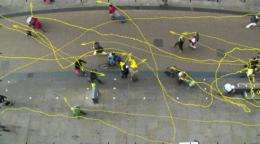April 24, 2012 report
Field experiments show less than expected response to gaze of others

(Medical Xpress) -- It’s sort of conventional folk wisdom, if someone in a crowd starts staring at something, soon someone else will too. Eventually the whole crowd will start staring, even if they don’t know what they are supposed to be looking at. The problem is, the whole idea is wrong, at least that’s what a group of researchers found when filming crowds and using gaming software to track the gaze of people who happen across someone staring at something. They find, as they describe in their paper published in the Proceedings of the National Academy of Sciences, that following the gaze of others is far less pervasive than has been generally thought.
The group undertook two studies. The first took place in Oxford in the U.K. on a busy shopping street. There the team set up a hidden camera in a tall building that looked down and taped people as they passed by and then used software to track the gaze of every one of them. They then hired actors to stop and stare up in the general direction of the camera. This arrangement allowed them to note how many people passing by stopped to look at whatever it was the actors were looking at.
The team found that on average 27% of people passing by stopped to have a look, and that men did so for slightly longer periods of time. They also found that those passing by were more likely to look up if they were walking slowly and if the crowd was thinner. They also found that more people looked up as more actors did so. One surprising result they found was that people tended to be more likely to look up if they were behind or to the side of the actors, and less likely to do so if they were walking directly towards the actors. Another was that far fewer people looked up than was expected and never did there come a point where more and more people looked up until virtually everyone joined in, refuting the common myth that crowds tend to do so.
In the second experiment, the team gave the crowd something to look at, figuring that perhaps it might cause more to look. This time they observed people passing at both a train station and on a busy shopping street. Actors were hired to behave “oddly” by brandishing cameras at odd angles or drawing things, etc. Behavior that has come to be seen as suspect of late. This time, they found that in the street scene, both genders tended to look more and longer. In the train station on the other hand, they found that while women tended to behave in much the same fashion as the first experiment, men did not. They averted their gaze, as if trying not to see what the actors were doing. But again, in neither case did some point come where more and more people stopped to stare until everyone joined in.
These experiments show, the team says, that crowd gazing is both predictable in some ways, and unpredictable in others, and that further research is needed to truly discern recognizable patterns that could be useful to both sociologist and those looking to protect the public from possible threats.
More information: Visual attention and the acquisition of information in human crowds, PNAS, Published online before print April 23, 2012, doi: 10.1073/pnas.1116141109
Abstract
Pedestrian crowds can form the substrate of important socially contagious behaviors, including propagation of visual attention, violence, opinions, and emotional state. However, relating individual to collective behavior is often difficult, and quantitative studies have largely used laboratory experimentation. We present two studies in which we tracked the motion and head direction of 3,325 pedestrians in natural crowds to quantify the extent, influence, and context dependence of socially transmitted visual attention. In our first study, we instructed stimulus groups of confederates within a crowd to gaze up to a single point atop of a building. Analysis of passersby shows that visual attention spreads unevenly in space and that the probability of pedestrians adopting this behavior increases as a function of stimulus group size before saturating for larger groups. We develop a model that predicts that this gaze response will lead to the transfer of visual attention between crowd members, but it is not sufficiently strong to produce a tipping point or critical mass of gaze-following that has previously been predicted for crowd dynamics. A second experiment, in which passersby were presented with two stimulus confederates performing suspicious/irregular activity, supports the predictions of our model. This experiment reveals that visual interactions between pedestrians occur primarily within a 2-m range and that gaze-copying, although relatively weak, can facilitate response to relevant stimuli. Although the above aspects of gaze-following response are reproduced robustly between experimental setups, the overall tendency to respond to a stimulus is dependent on spatial features, social context, and sex of the passerby.
© 2012 Medical Xpress


















